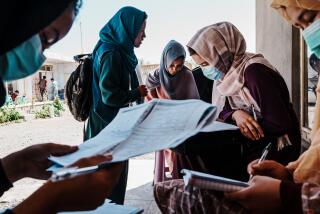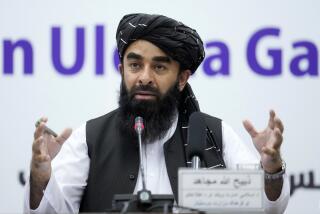In Afghanistan, spring could prove test of anti-Taliban effort
It was a classic photo opportunity: the governor of Kandahar province astride a lumbering farm tractor, plowing under the first green shoots of opium poppies poking their way through the soil. The engine clattered; the cameras clicked away. “Enough?” the governor asked, and clambered down.
Just outside the photo frames, truckloads of Afghan police and a convoy of U.S. armored vehicles stood guard over this drug-eradication exercise a half-hour west of Kandahar, the main city of southern Afghanistan. Asked whether the governor and his entourage could have visited this spot without U.S. firepower at the ready, an Afghan police commander laughed heartily.
“Sure, we could come here,” he said. “But we might not come back!”
Zhari district, where Mullah Mohammed Omar founded the Taliban movement in the 1990s, could prove a key testing ground as insurgents launch an expected spring offensive in coming weeks. In September, a U.S.-led military operation to secure strategic districts on Kandahar city’s outskirts drove the Taliban from long-held bases here.
That campaign was part of an ambitious Western bid to seize the battlefield initiative across Afghanistan’s south, and to begin laying the groundwork for a transfer of security responsibilities to Afghan police and soldiers over the next three years.
Senior U.S. officials, including Gen. David H. Petraeus and Defense Secretary Robert M. Gates, who visited bases in the south this month, insist that the insurgents will find it difficult to regain a foothold in areas “cleared” in last year’s fighting.
“We think that what they’re returning to is a significantly different environment than what they left last year,” said Lt. Gen. David Rodriguez, the NATO force’s deputy commander.
But longtime observers of the Taliban point out that the movement does not necessarily need to hold territory to make its influence strongly felt. Even in small numbers, its fighters can use hit-and-run guerrilla tactics, tying down large numbers of coalition troops. And even through the winter months, as combat trailed off, the insurgents were able to employ improvised explosive devices, or IEDs, to bloody the far more powerful NATO force. Civilians, too, are dying at an unprecedented rate.
Taliban fighters “are not going to charge back in here like the cavalry in your Old West movies,” said an official in Kandahar, who spoke on condition of anonymity because of insurgent death threats against him. “They can’t. But they don’t have to. They can come in quietly.”
That pattern can already be seen in Zhari. Villagers said the insurgents melted away for much of the winter, as they customarily do — with some disappearing even before the U.S. offensive last fall. But as the weather has warmed, they say, fighters have been stealthily reestablishing themselves, slipping into the district in ragged, inconspicuous bands of three or four, uncovering buried weapons caches, availing themselves of eyes and ears in every hamlet.
Western officials have touted the success of raids, mainly carried out by special operations forces, that they say have killed or captured nearly 3,000 Taliban suspects over the last three months, including many in the movement’s mid-level command tier. Senior commanders have described these raids as a devastating blow to the insurgents’ fighting ability.
But the Taliban movement is known to have an enormous recruiting pool in the Islamic seminaries of Pakistan, whose tribal borderlands offer a plethora of havens where foot soldiers can be trained and armed before being sent into battle in Afghanistan.
The loss of experienced commanders is undoubtedly being felt as the insurgents seek to regroup, according to several people familiar with the Taliban field structure. But replacement leaders at the squad level are consistently described as younger, more ruthless and more ideologically driven, which could heighten the level of violence.
Moreover, the movement has historically been able to absorb large numerical losses. In Zhari, for example, an offensive by Canadian forces in 2006 was thought to have killed more than 1,000 insurgents. But within 18 months, Taliban fighters had once again ensconced themselves in the district.
A primary goal of the offensive in Kandahar’s outlying areas was to make the city safer, enabling better governance to take hold. But despite a drop-off in suicide bombings and other large-scale attacks, the sinister phenomenon of Taliban targeted killings expanded in the province last year.
Hit teams, often a pair of assailants on a motorbike, routinely target tribal elders, elected officials and local dignitaries. And attacks on government and security installations in the city have not halted altogether.
“They can still do this when they want to,” said shopkeeper Ghulam Hazrat, gesturing at a ruined complex of shops and a wedding hall in Kandahar’s city center. Taliban gunmen and suicide bombers overran the building last month and used it to lob rockets at police headquarters across the street.
Many people fear, in fact, that the tightening NATO hold on the outlying districts has caused insurgents to seek shelter in the city itself. “I think some of the ones who were in the countryside before are in Kandahar now, and will stay here,” Hazrat said.
The Taliban leadership pays close attention to Western policy pronouncements. During his visit, Gates declared that U.S. forces would be “well-positioned” to begin at least a limited troop drawdown in July, as promised by President Obama. But insurgents may be highly motivated to ensure that the timing for any pullback is problematic.
Last year, June and July brought the largest number of combat losses for both U.S. troops and the NATO force as a whole. A similar pattern this year would mean that American troop reductions occurring around that time would be painted as a Taliban victory.
In addition, the spring will test a gamble by the North Atlantic Treaty Organization force in eastern Afghanistan, where U.S. troops are being withdrawn from areas once described as crucial bulwarks against Pakistani-based militant groups such as the Haqqani network and the Hezb-i-Islami faction led by Gulbuddin Hekmatyar.
U.S. troops have been “repositioned” away from former battlegrounds such as the Pech and Korangal valleys in Kunar province, where commanders said sophisticated surveillance and “intelligence-driven” raids would prevent a rush of cross-border movement.
However, replacing troops with a reliance on airstrikes could lead to a surge in civilian casualties, already a highly sensitive issue between President Hamid Karzai’s government and the NATO force.
The spring’s new round of fighting will be as much a battle of perceptions as a struggle for territory. Despite the upbeat military assessments, many Afghans are feeling less secure than ever. Civilian deaths have hit their highest recorded levels of the decade-old war, with fatalities in 2010 increasing by 15% over the previous year, a United Nations report said this month. Three-quarters of those deaths were blamed on the Taliban and other militant groups.
The first two months of this year also saw a string of suicide bombings and other attacks in urban centers across the country that killed scores and created a sense of enveloping chaos.
“To me, the question is whether we can somehow live our daily lives,” said Mohammed Ahmadi, whose policeman son was shot point-blank by insurgents last month as he tried to draw his pay at a bank in the eastern city of Jalalabad. “Right now, it seems there is death everywhere we turn.”
Times staff writer David S. Cloud in Sangin, Afghanistan, contributed to this report.
More to Read
Start your day right
Sign up for Essential California for news, features and recommendations from the L.A. Times and beyond in your inbox six days a week.
You may occasionally receive promotional content from the Los Angeles Times.






